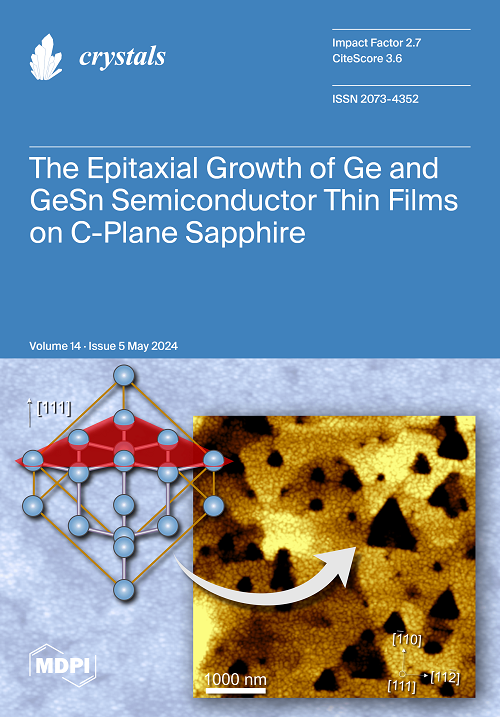掺氮 CVD 合成金刚石的光谱特性与表面蓝色荧光的起源
IF 2.4
4区 材料科学
Q2 CRYSTALLOGRAPHY
引用次数: 0
摘要
近年来,关于CVD金刚石生长的研究很多,但CVD金刚石在超深紫外辐射下(即在DiamondView下)产生不规则蓝色表面荧光的原因仍不清楚。在此,我们分析了一批来自中国浙江某公司的CVD合成金刚石样品的各种光谱(红外光谱、紫外吸收光谱、拉曼光谱和光致发光光谱)特性,以探索表面蓝色荧光的来源。结果表明,样品是掺氮的 IIa 型 CVD 合成金刚石。这些样品中不存在早期 CVD 产物的光谱峰,例如 3123 cm-1 (NVH0)(红外吸收光谱)和 596/597 nm(PL 发射光谱),而紫外光谱或 PL 光谱中 736.5/736.8 nm (SiV-) 处的峰则不常见。PL 光谱和 DiamondView 荧光显示,这些样品在 NV- 中心的 637 nm 和 NV0 中心的 575 nm 处一般都有较强的发光峰,其他发光峰是由氮相关缺陷引起的。在 DiamondView 下观察到的原生长样品显示出橙红色荧光,并伴有因阶梯流生长而产生的条纹,蓝色荧光在表面呈现为不规则的线或束。LPHT 退火样品的荧光较弱,由弱 H3 中心产生的局部绿色荧光斑块。显微红外光谱表明,CVD 金刚石中独特的蓝色荧光可能与原材料中碳氢基团脱氢不完全导致的 sp3-CH2 位错有关。本文章由计算机程序翻译,如有差异,请以英文原文为准。
Spectral Characteristics of Nitrogen-Doped CVD Synthetic Diamonds and the Origin of Surface Blue Fluorescence
In recent years, many studies have been published on CVD diamond growth, but the reason for the irregular blue surface fluorescence of CVD diamond under ultra-deep UV radiation (i.e., under DiamondView) is still unclear. Here, a batch of as-grown and LPHT-annealed CVD synthetic diamond samples from a Chinese company in Zhejiang were analyzed for the various spectral (infrared (IR), UV–visible absorption, Raman, and photoluminescence (PL)) characteristics to explore the origin of surface blue fluorescence. The results show that the samples are nitrogen-doped type IIa CVD synthetic diamonds. Spectral peaks of the earlier CVD products, e.g., 3123 cm−1 (NVH0) (IR absorption spectrum) and 596/597 nm (PL emission spectrum), are absent in these samples, while the peaks at 736.5/736.8 nm (SiV−) in the UV or PL spectra are less common. PL spectra and DiamondView fluorescence indicate that the samples have generally strong luminescence peaks at 637 nm in the NV− center, 575 nm in the NV0 center, and other luminescence peaks caused by nitrogen-related defects. The as-grown samples observed under DiamondView show orange-red fluorescence accompanied by striations due to step-flow growth, and blue fluorescence appears as irregular threads or bundles on the surface. The LPHT-annealed sample shows weaker fluorescence with localized patches of green fluorescence contributed by weak H3 centers. The micro-IR spectra suggest that the unique blue fluorescence in the CVD diamond may be related to the dislocations caused by sp3-CH2 due to the incomplete dehydrogenation of hydrocarbon groups in the raw material.
求助全文
通过发布文献求助,成功后即可免费获取论文全文。
去求助
来源期刊

Crystals
CRYSTALLOGRAPHYMATERIALS SCIENCE, MULTIDIS-MATERIALS SCIENCE, MULTIDISCIPLINARY
CiteScore
4.20
自引率
11.10%
发文量
1527
审稿时长
16.12 days
期刊介绍:
Crystals (ISSN 2073-4352) is an open access journal that covers all aspects of crystalline material research. Crystals can act as a reference, and as a publication resource, to the community. It publishes reviews, regular research articles, and short communications. Our aim is to encourage scientists to publish their experimental and theoretical results in as much detail as possible. Therefore, there is no restriction on article length. Full experimental details must be provided to enable the results to be reproduced. Crystals provides a forum for the advancement of our understanding of the nucleation, growth, processing, and characterization of crystalline materials. Their mechanical, chemical, electronic, magnetic, and optical properties, and their diverse applications, are all considered to be of importance.
 求助内容:
求助内容: 应助结果提醒方式:
应助结果提醒方式:


